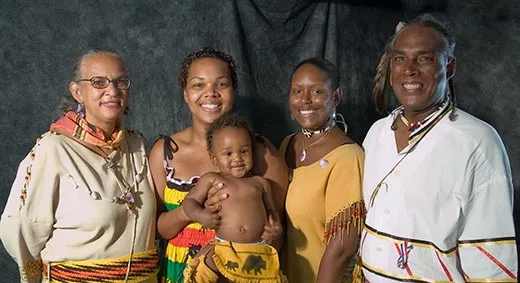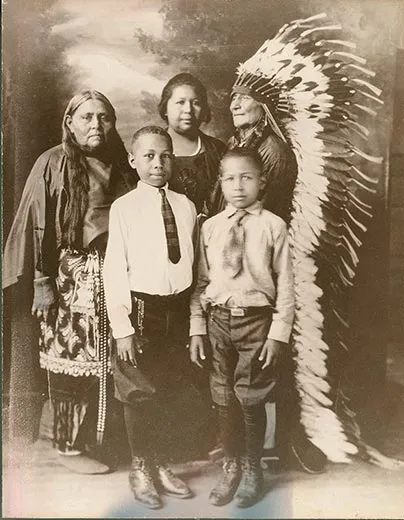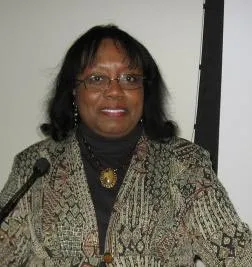An Ancestry of African-Native Americans
Using government documents, author Angela Walton-Raji traced her ancestors to the slaves owned by American Indians
/https://tf-cmsv2-smithsonianmag-media.s3.amazonaws.com/filer/Comanche-family-631.jpg)
Angela Walton-Raji has been researching African-Native American genealogy for nearly 20 years and is the author of the book Black Indian Genealogy Research: African-American Ancestors Among the Five Civilized Tribes. She recently presented a series of genealogy workshops at the National Museum of the American Indian in Washington, D.C., in conjunction with the exhibit IndiVisible: African-Native American Lives in the Americas. Walton-Raji’s ancestors are Freedmen, African-Americans who were slaves of the Five Civilized Tribes – the Cherokee, Chickasaw, Choctaw, Creek and Seminole Nations – in Indian Territory, which became Oklahoma in 1907. The Cherokee freed their slaves in 1863, and after the Civil War, the other tribes did the same. All but the Chickasaw eventually granted Freedmen full citizenship in their tribe. In preparation for Oklahoma statehood, the U.S. Congress created the Dawes Commission, which was charged with dissolving collective tribal land ownership and allotting land to individual tribal members. Thousands of Freedmen came before the commission to prove their tribal membership and their right to a share of land. I spoke with Walton-Raji about her research.
What spurred you to start researching African-Native American history and genealogy?
I was inspired to begin the research because it’s part of my family history. I’m originally from western Arkansas and eastern Oklahoma, right there on the border. My great-grandmother Sallie Walton was born in Indian Territory, in the Choctaw Nation. She died in 1961 – I knew her very well. She was my babysitter until I went to kindergarten. [Her Choctaw heritage] was widely known in terms of family history. And growing up in a city such as Fort Smith, Arkansas … if you’re on the north side of the city, you can look at the Cherokee Nation, and if you’re on the south of the city, the bordering community is the Choctaw Nation.
I did have in my possession some family papers – a small land allotment record from [Sallie] that she had obtained from the Dawes Commission. I had been doing genealogy for many years but was curious, “Gee, is there more information out there to be found?” I really didn’t know what there was to find. So when I moved to the Washington, D.C., area and had access to the National Archives … I went and started looking and found family records, and I was just amazed.
What did you find?
I found a [Choctaw Nation] enrollment card for Samuel and Sallie Walton, my great-grandparents. And then my grandfather, Sam, Jr., was recorded there, my Uncle Houston’s name was there, my Aunt Louisa’s name. I was like, “Wow, I didn’t realize there was a document that reflected this!” On the reverse side of that same card, which was the next exposure on microfilm, was information about [Sam and Sallie’s] parents. Here was additional information about his mother, his father and her mother and her father – there were four new ancestors! But beyond that, I also found an interview with my great-grandmother and great-grandfather about their life in the Choctaw Nation. I had known of Samuel Walton but did not realize he was originally born in Arkansas and had later been sold as a slave to someone in the Choctaw Nation. I also began to recognize surnames of people whom I had grown up around. I realized, here’s an entire record set reflecting people who had been slaves of Choctaw Indians, many of whom had Choctaw blood … an entire record set of African-American people that had never been talked about.
You’ve said the Freedmen have been “deleted” from American history in the past. What do you mean?
One hears, for example, about the forced migration of native people. One does not hear about the 1,200 slaves that were taken west with the Cherokee Nation. One does not read in history books that many people who were Choctaws – and the Choctaws were actually the first group that migrated, in the winter of 1830 and 1831 – sold personal property to be able to purchase slaves to take with them to Indian Territory. Pull up any history book or just Google “map reflecting slavery,” and you’ll always see the map of what is called “the South” and you see that empty spot that [would be] Oklahoma, and it looks as if there was no slavery taking place there. When the treaty of 1866 finally abolished slavery in Indian Territory, the fact is that a community thrived – a community of people who were not slaves of the United States, and they were Freedmen.
What have you found in your research about how blended families – those with native, African and Anglo roots – historically identified themselves? Obviously there were limitations on what box they could check on the census form, for example.
And they weren’t allowed to check – it was somebody else checking the box.
So how did people present themselves to the community?
Self-identity is one thing and then a perceived identity is another. When you’re talking about perceived identity, that’s usually a census enumerator who was going around from house to house and was usually white and male. In Lake Charles, Louisiana, for example, an entire Indian village was captured in the census records … [but] the enumerator didn’t get the names of everyone. They would just write the name of a person such as “Baptiste” and say “his wife, his son, his daughter” without giving them a name. So more than likely that enumerator was not comfortable going into the Indian village … and just did a count without interacting with the people themselves. I always ask people to research an [ancestor] throughout their entire lifetime, and if this ancestor is continually identifying themselves differently than a descendent might claim – in other words, this descendent is claiming the ancestor was a Native American, but throughout that ancestor’s life they are identifying themselves as black – then one has to really look and say “Hmm, was this person really living in a Native American community?” Or is it a way to explain a light complexion that makes the family feel better than acknowledging that maybe this person’s mother or grandmother was involved in a relationship against her will? Some people may want to disassociate their family from having a blood tie to a slave master.
And on the other hand you’ll find some white families who don’t want to acknowledge having a black ancestor in the family and will claim, “This complexion came from an Indian relative.” I always say if you are a serious researcher, you follow the records.
What documents and records are there for the Freedman of the Five Civilized Tribes?
For Freedmen of Oklahoma, the source is amazing. There is a microfilm publication at the National Archives that consists of Freedman enrollment cards [for] individuals who had been enslaved (or their parents had been enslaved) by citizens of the Five Civilized Tribes. Those individuals were eligible to receive land allotment. Data was collected on each person who was applying [for land], usually the head of the household, about where they lived and who their slave owner was.
These interviews took place in the 1890s and slavery officially ended in 1866 in the Territory. The reverse side of the enrollment card is the name of the person’s parents – the father’s tribal enrollment, the name of the father’s slave owner if the father had been enslaved. In many cases, particularly in the Choctaw Nation and Chickasaw Nation, you’ll find that the father was actually an Indian. Then, the name of the person’s mother and her tribal enrollment … and the name of the mother’s slave owner. If on one side of the card you have a husband, his wife and their children, and on the reverse side you get the names of their parents, that means you have three generations on one card. Then, there’s an interview packet that contains hundreds of reels of microfilm of the actual interviews: “Sam Walton, sworn in under oath, testifies as follows…What is your name? Were you a slave? Where did you live? Who was your owner?”
What was the purpose of these interviews?
These gave the Dawes Commission information to decide whether or not a family should get a land allotment. Land was held in common by the tribes, and Freedmen were members of the tribe after 1866, because they didn’t have anywhere else to go [and] that was their home since the 1830s. So they remained where they were, they spoke the language. But Oklahoma statehood was approaching, and before the rest of the land could be released for white settlers to come in, the [U.S. government] decided to take the land that was held in common by the tribes and redistribute it to the individual members – the Western tradition of personal property.
What has been the reaction of your family to your research? What have you found that has surprised them?
I think the biggest surprise for my brother and I, who remember Sallie … was that both of us knew someone who had been born a slave. She was born in the middle of the Civil War in 1863 and she died in 1961.
Did she tell you she’d been born into slavery?
No, she didn’t. She had no memory of it. And also, children don’t know to ask their elders, “Tell me about your life when you were a child.” … My dad knew of his very strong ties to the Choctaw Nation, which was spoken about in everyday conversation, so that wasn’t new, but … I didn’t know this part of Sallie’s early history. Of course, where I grew up, everybody knows they have some ties to [Indian] Territory. In Fort Smith, everybody has cowboys, Indians, marshals and outlaws in their family.
What is your advice to people who want to start researching their African-Native American heritage?
Your heritage is your heritage, whether it’s white, whether it’s black, whether it’s blended, whether it’s a family of immigrants or a family native to the Americas. Your family history is done using the same methodology, regardless of ethnicity. You’re going to start with your oral history – you’re going to sit down and talk with your elders, and you’re going to talk with them more than one time. Transcribe those interviews. Even before you leave the house, you’re going to look and see what you have in the house – for example, I had some documents that were folded up in little pieces in Samuel Walton’s old Bible. There was Sallie’s land allotment information with “Choctaw Nation” stamped at the top. At some point you will be ready to start obtaining those vital records, and the most important thing is that you don’t skip back 100 years – you start with things that are more recent.


